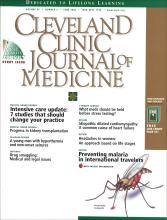ABSTRACT
Effective headache management in women requires an understanding of the unique epidemiologic and pathophysiologic factors affecting women. We present preventive, abortive, and nonpharmacologic approaches to headache treatment that vary with the chronologic and hormonal stages of a woman’s life, with special attention to headache during pregnancy and later in life.
Footnotes
↵* The author has indicated that she has received grant or research support from the AstraZeneca and GlaxoSmithKline corporations, serves as a consultant for the AstraZeneca, GlaxoSmithKline, and Merck corporations, and is on the speakers’ bureaus of the AstraZeneca, GlaxoSmithKline, and Merck corporations.
↵† The author has indicated that she has received grant or research support from the Abbott, Bayer AG, Bristol Myers Squibb, GlaxoSmithKline, Janssen, Mylan, Novartis, Pfizer, Vanguard Medica, Wyeth-Ayerst, and AstraZeneca corporations, serves as a consultant for the Elan Pharmaceutical, GlaxoSmithKline, and Merck corporations, and is on the speaker’s bureaus of the AstraZeneca, Bristol-Myers Squibb, GlaxoSmithKline, Merck, Novartis, and Wyeth-Ayerst corporations.
↵‡ The author has indicated that she has received grant or research support from the Allergan, Elan, Glaxo-Wellcome, Merck, and Pfizer corporations, serves as a consultant for the Glaxo-Wellcome and Merck corporations, and is on the speakers’ bureaus of the Glaxo-Wellcome and Merck corporations.
- Copyright © 2002 The Cleveland Clinic Foundation. All Rights Reserved.






